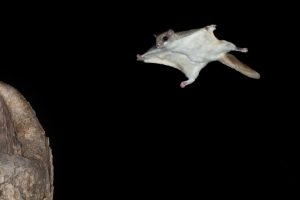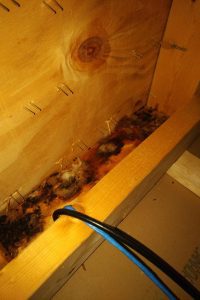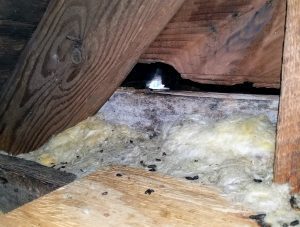HOW COME WE NEVER SEE FLYING SQUIRRELS?
By Chris Williams on June 4, 2018.
People are often surprised to find out that they have flying squirrels in their neighborhood, and even more surprised to find out that it’s flying squirrels that are making that mess in their attic.

Flying squirrels are very cryptic, almost never seen except by those who make an effort. That’s mostly because, unlike other squirrels, flying squirrels are nocturnal, being most active at dusk and dawn. And when they are active, activity is usually limited to treetops – unless they’re in your attic (see When Flying Squirrels Move Into Your Attic…). If you see a flying squirrel on the ground during daytime, it’s probably in trouble?
Flying squirrels are smaller than gray or red squirrels, about the size of a chipmunk. They have large dark eyes and lots of extra loose furry skin that when stretched out between their legs turns them into a hairy kite, allowing them to glide from high places (see How Do Flying Squirrels Fly?). Their tail acts as a rudder and they can swoop and turn, usually traveling distances of 20-60 feet. They feed on moss, nuts, buds, insects, and even bird eggs and nestling birds. They can also do a job on your bird feeder at night.
ATTIC WINTER DENS CAN HAVE LOTS OF FLYING SQUIRRELS
Flying squirrels compete with woodpeckers and gray squirrels for tree cavities to use as nest sites, but sometimes they move indoors. Most people first come across flying squirrels during winter months when they discover that they are playing host to several squirrels trying to stay warm in their attic. The average winter den in our area contains about 6 flying squirrels but there can be as many as 30 squirrels sharing quarters.

Beginnings of the latrine. Z. Ciras
The biggest problem with flying squirrels in an attic, besides the nighttime noise from the hyperactive critters, is that an extended family will use a communal latrine. They all poop and pee in the same spot, usually in a dark corner under the roof overhang. That can result in brown fecal liquids running down the outside of your house!
Breeding season for flying squirrels in our region is March to May. The young are weaned in 6 to 8 weeks but stay with mom until they learn to glide at about 3 months. Fortunately, breeding nest sites are usually in tree cavities instead of attics. However, since flying squirrels often move or change their dens, they can sometimes end up in attics for short periods during the summer.
IT’S TIME TO SEAL OPENINGS INTO YOUR ATTIC

Flying Squirrel Hole in an attic. L. Carreau.
All types of squirrels will enter through openings around the roofline: damaged or rotting fascia boards, dormer corners, knot holes, vents, or uncapped fireplaces. If an opening is not big enough, squirrels will chew to make it bigger. Gray squirrels can get onto a roof by following a touching tree branch. Flying squirrels, though, don’t need branches to touch the roof. They can glide onto a roof from high up on a nearby tree. And they don’t need a very big opening to get into your house.
If you’ve ever had, or suspected, squirrels in your attic, you need some squirrel-proofing work done by an expert (see How to Keep Flying Squirrels Out of Your Attic).Give Colonial Pest a call. We have certified, trained nuisance wildlife experts on staff that can remove squirrels, and technicians that specialize in finding and sealing openings that let squirrels and other pests inside. Now is a good time to seal up your attic before squirrels return. Our squirrel exclusion work is permanent and guaranteed. Give us a call today!